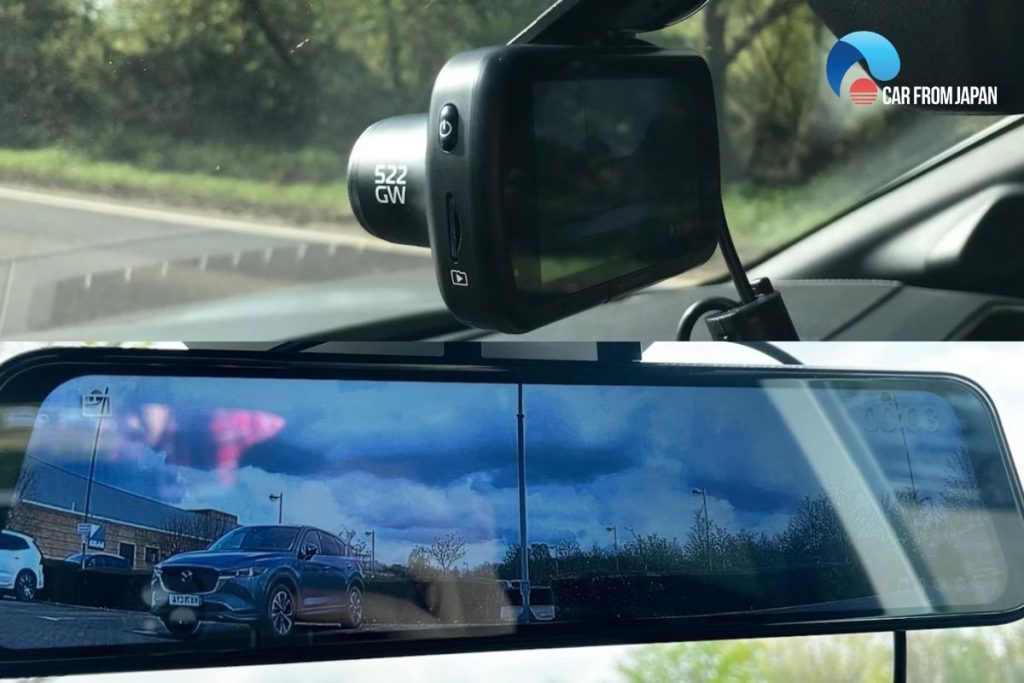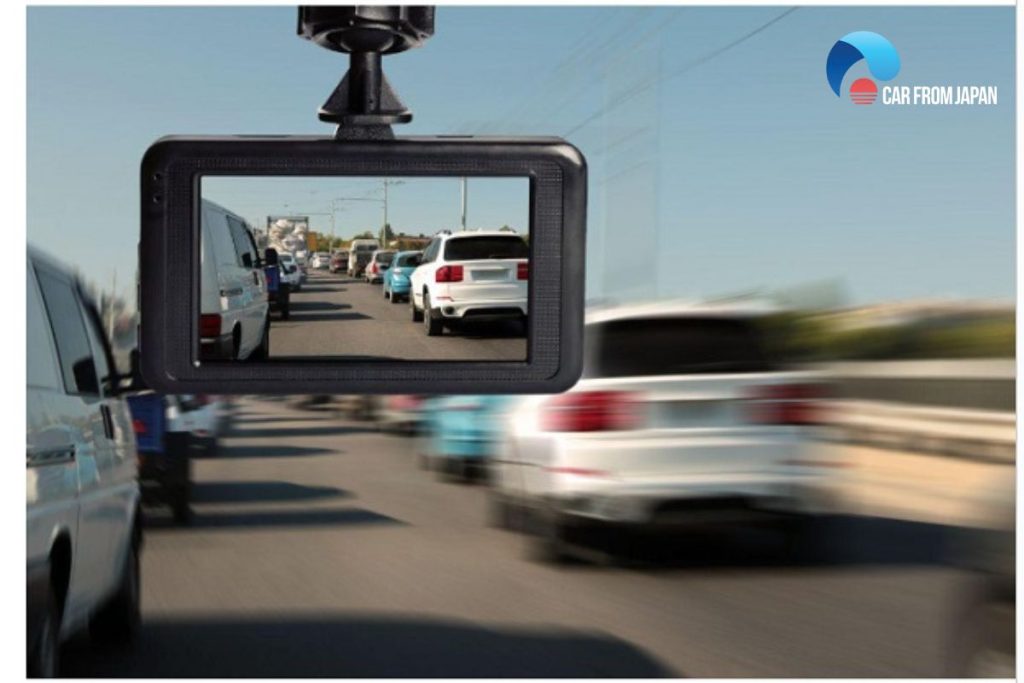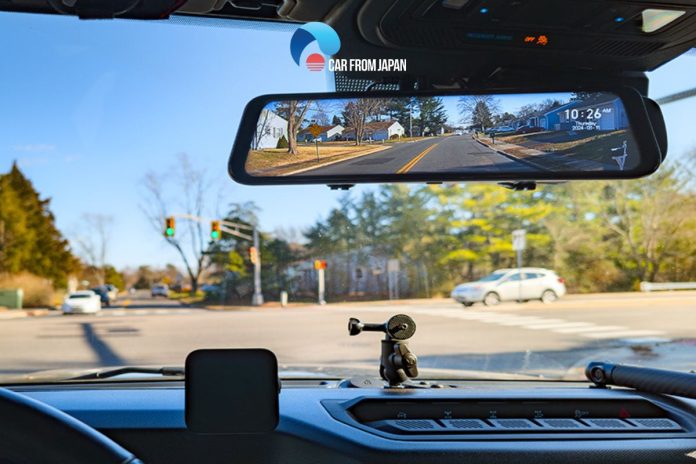If you are thinking about getting a rear view mirror for your vehicle, you’re not alone.
Today’s drivers would love to have that added safety and increased visibility without having to deal with cluttering their windshields with bulky devices.
A rear view mirror dash cam provides a clear view of the road, along with the option to record what’s going on in front and back of your car.
It appears to be a standard rear view mirror, but adds features such as a display screen, backup view, and in this case, a built-in recording mechanism, all in 1 device.
We’ll show you how to choose the model that’s best for you in this guide.
Whether you have to drive in bumper-to-bumper traffic daily, park in tight spots, or just want some extra peace of mind, this easy how-to guide will make sure you choose a smart option.
Contents
What Is a Rear View Mirror Dash Cam?
A rear-view mirror dash cam is a dash cam that attaches to your rear view mirror facing outwards to record everything going on in front of the vehicle when you are driving.
The majority of models have a built-in screen that replaces your standard mirror reflection with a live video feed.
Typically, these are cameras with a front lens that records the driver’s view outside the car and a rear-facing camera that assists with backing up the car or parking.
If you do not want a dash cam suction cup on the windshield, this would avoid blocking your sight and exposing your wire on the windshield.
Some attach to your existing car rear-view mirror, while others become the car rear-view mirror.
There are models that are equipped with a rear-view mirror backup camera, night vision, parking assistance, and you will find auto-dimming rear-view mirror options for those who do a lot of night driving.
If you want a clean and simple way to capture your drives, a dash cam rear view mirror is one possibility.
Why Many Drivers Choose Mirror Dash Cams?
Has an awkward, boxy dash cam ever pissed you off, stuck to your windshield, and does a mess of wires ever get tangled up in everything?
That’s one of the main reasons drivers are switching to rear view mirror dash cams: they simply look more built-in and less like an addition.
It Keeps Your Setup Clean
They mount over your existing rear view mirror, so there are no ugly suction cups, additional screens, or devices to clutter your dashboard.
Everything stays put, in the one place where you’d expect to find it.
You Get a Better View Behind You
Instead of using a standard auto rear-view mirror, a live feed from the rear camera will appear on the mirror display.
It’s come in handy on the night shift and in bigger vehicles, where the back window isn’t always visible.

It Records Front and Back at the Same Time
With both front and rear cameras built in, your drives are covered from multiple angles. This comes in handy not just for accidents, but for keeping an eye on traffic or even someone backing into you while parked.
It’s Simple to Use
Most models come with a touch display right on the mirror. You can adjust settings, switch views, or check footage without fiddling with your phone or going through confusing menus.
Less Wiring to Deal With
Since everything is installed in one location, it’s simpler to get your wires tucked behind your trim or your headliner. That equals fewer cables, obviously showing, and a cleaner overall look.
For many drivers, it’s an easy upgrade that makes a big impact on real-world use, be it all about staying safe on the road, or you simply want a more modern setup without the fuss.
How to Choose the Right Mirror Dash Cam?
Picking out a mirror dash cam isn’t about getting the one with the most features; it’s about getting the one that’s right for your driving style.
Here’s how to make it manageable, step by step:
Step 1: See If It Will Fit Your Vehicle
First, assess whether the dash cam can mount firmly onto your rear-view mirror. Most models are designed for standardized sizes, but if you own a truck or a car with a thick mirror housing, verify the product’s dimensions before buying.
Step 2: Determine What You Want to Record
Some dash cams only provide front coverage, while others come with a rear view mirror backup camera.
If you’re back into traffic, are in a lot of stop-and-go situations, or try to painstakingly protect yourself and your precious paint job from any possible back-end collisions, a front/rear camera would be more appealing to you.
Step 3: Choose the Right Video Quality
At a bare minimum, look for full HD (1080p), but if you would like to be able to make out details such as license plates or nighttime performance, consider something with a resolution of 2K or 4K.
Step 4: Think About How You’ll Power It
As for plug-and-play operation, most cams plug into the 12V outlet. If you’re interested in parking mode features, you will need a hardwire kit to connect the system directly to your car’s fuse box.
Step 5: Consider Useful Features
Not all features are necessary. Focus on what matters to you, like a large touchscreen, parking assistance lines, GPS, or an auto-dimming rear view mirror for night driving.
Step 6: Check the Storage Support
Confirm that the dash cam is compatible with the correct size and class of microSD card. The top-end models may handle cards up to 128GB or even more for longer coverage.
Step 7: Match It to Your Budget
You don’t have to spend a lot to get a solid device. Basic models cover essential recording, while mid-range versions offer more features like app support or a digital rear-view mirror display.

Why Choosing the Right One Actually Matters?
It’s easy to assume all rear view mirror dash cams do the same thing, record what’s in front and behind your car, but the truth is, there’s a big difference between a model that works well for you and one that just adds clutter.
Take some time to consider how and where you drive. If you’re working your way across the city in a compact sedan, a compact that offers just the basics could get the job done.
But if you drive an SUV, stake parking along busy streets, or do a lot of down-the-highway long hauls, you’ll probably benefit from one that adds a rear view camera in the mirror, improved night vision, and a wider field of view.
Some are loaded with features you’ll probably never use, such as driving assistance alerts or parking line overlays, while others are so basic they’re missing critical components, such as a rear camera or decent screen quality.
Your car’s size, your driving frequency, the location you park in, and how much time you want to spend setting things up should all be factors that guide your choice.
Choosing a dash cam is about more than ticking off boxes for features; it’s about finding something that fits into your routine and then stays out of the way.
To Sum Up
Selecting the right rear view mirror dash cam might seem like just picking the flashiest camera on the shelf, but giving it some thought and matching it up with your car, your driving habits, and the features you’ll use can go a long way.
One that fits you well, records what you need it to, and stays out of your way is what most drivers want, not the most expensive or the flashiest.
By working through what you need, from video quality to where the cameras should go, from storage space to the power setup, you will finish with something that works every day, and not just in theory.
Whether you’re protecting yourself in case of an accident, backing up and parking with confidence, or simply logging everything you encounter in case you need to rewatch it later, the best dash cam should feel like a natural part of your car.



